This blog series, Aesthetics and Spirituality, has been devoted to uncovering global aesthetic responses to shared spiritual impulses. My posts have shown, I hope, that humans are spiritual animals immersed in a shared metaphysical ecosystem that elicits similar, beautiful responses all over the world.
Here are some examples. Most world cultures have situated their sacred buildings at high points, and have evolved pilgrimage roads to access those places. Most world cultures have also lavished time and expense on tombs for their dead, their eyes trained on an afterlife deeply perceived. In addition, most world cultures have venerated similar objects—relics, statues, or later, images—that have potently evoked revered holy figures.
I believe alien visitors to our planet, able to see the forest before the trees, would be astonished by the harmony and predictability of human spiritual culture. Then, with awe, they might glance back over their own, extraterrestrial shoulders, wondering what Being from without had exerted such power.
In the final blog post of this series, I will discuss the city of Rome, Italy. As one of the oldest and largest continually inhabited cities in the world, Rome boasts every kind of spiritual artifact discussed in previous posts. A close look at the city of Rome will demonstrate two important things. First, it will show how all of these spiritual artifacts are meant to work together toward a meaningful whole—something like what the composer Richard Wagner called a gesamtkunstwerk or “total work of art.” And second, because Rome is a city in which ancient spiritual traditions are also living traditions, it will show how such spiritual artifacts can be (and are) relevant for the modern world.
City as Mountains, City as Sky
When the French-American artist Pierre Charles L’Enfant designed the plan for Washington D.C. (at the behest of the far-seeing George Washington), he must have had Rome in mind. Washington D.C. is famous for radial streets that converge on “sacred” points, such as the Capitol Building and the Lincoln Memorial. This creates a momentum of pilgrimage even in daily life, and it highlights the secular “gods” pivotal to America’s founding. Central D.C. today is a tribute, in blazing-white marble, to a roman ideal of reality and eternity synthesized—of supernatural majesty made present on the Earth.
In Rome, Italy, today, the brisk clarity of radial pilgrimage streets converging on sacred points is a little harder to feel in one’s bones. Archaeological excavations, together with the awkward superimposition of mass transit and other modern systems, have covered up a structure once more crystalline.
But it’s there. And it’s there because Christians over the ages identified sacred places, distinguished them with monuments and towers, and built wider and straighter streets in order to access them. Rome is a constellation whose stars, with interlacing rays, create a “heaven” of blazing points to visit—and most of these points are “high.”
A famous high point, upon which many streets converge, is of course the Basilica of St. Peter’s, cloaked behind by the walls of Vatican City. Though built at a relatively low point geographically, St. Peter’s is by far the largest church in the world—a mountain of its own–and seems to beckon from miles around.
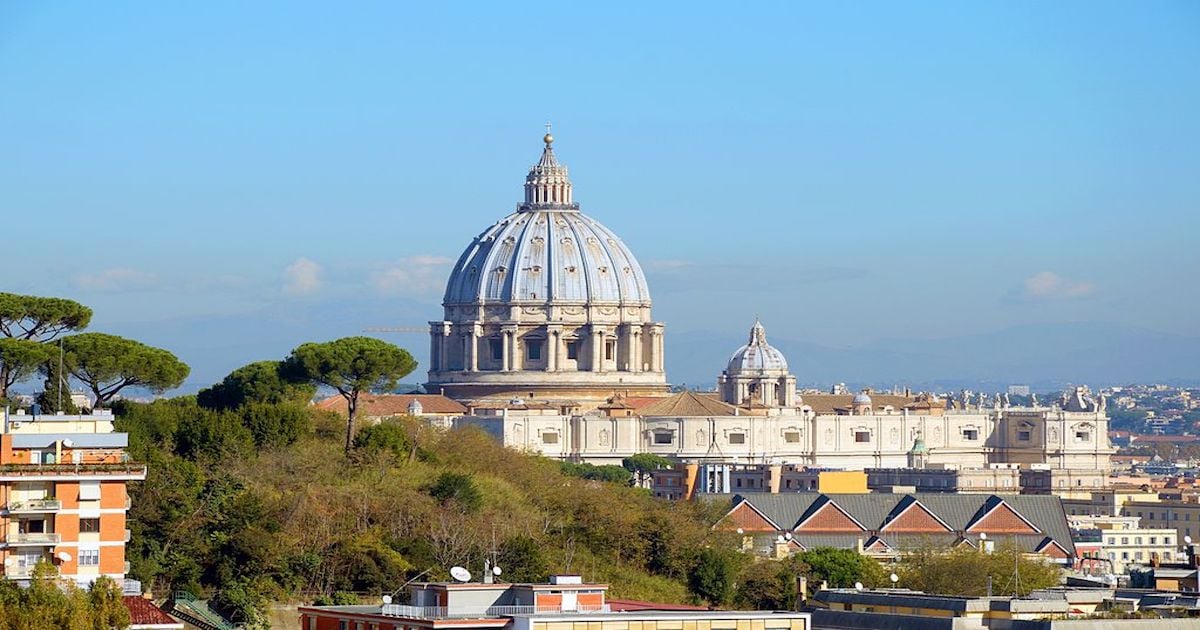 Livioandronico2013 / CC BY-SA 4.0, via Wikimedia Commons
Livioandronico2013 / CC BY-SA 4.0, via Wikimedia Commons
Further east, other streets converge around the church of Santa Maria Maggiore, a huge and ancient structure dedicated to the Virgin Mary, which sits atop Esquiline Hill. Around Santa Maria Maggiore, like foothills emerging from the larger mountain, smaller pilgrimage churches have sprung, often dedicated to woman martyrs.
In the southeast, radial streets converge on the important church of Saint John Lateran, with its beautiful cloisters and ancient baptistery. Further to the west, radial streets converge on the Romanesque structure of Santa Maria in Trastevere.
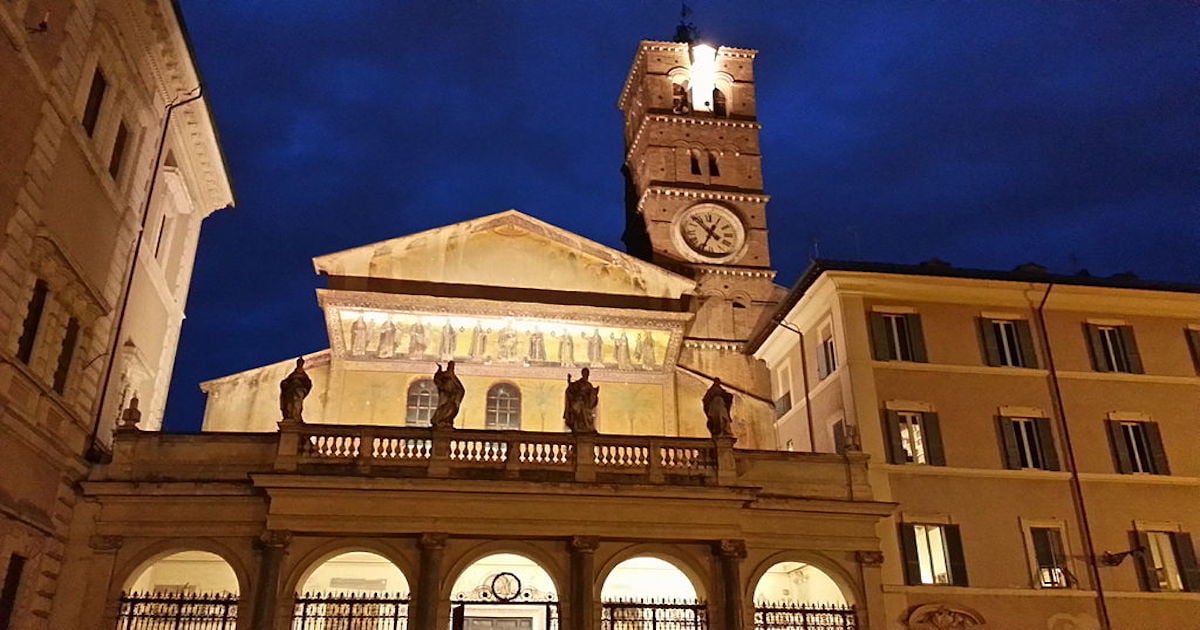 Statistenfreund007 / CC BY-SA 3.0, via Wikimedia Commons
Statistenfreund007 / CC BY-SA 3.0, via Wikimedia Commons
Indeed the whole city of Rome, looked at from above, is a pilgrimage network of major roads, branching into smaller ones, each leading to unique and special sacred points of varying loftiness and splendor.
Lodestars
All the churches above, of course, were anciently founded and gave rise to the networks around them. They made the loom upon which Rome’s medieval street grid was woven. St. Peter’s was built on the site of the Apostle Peter’s martyrdom, which took place around A.D. 60. Santa Maria Maggiore was built on a spot named in a mystical vision from the fifth century. Santa Maria in Trastevere was founded in the third century, perhaps near the spot of a miraculous fountain of oil. Only the fourth-century St. John Lateran had more quotidian (but still distinguished) origins: the land where this church was built was the first gifted by the Roman Emperor Constantine to the newly legalized Christian church.
All of these structures also hold important relics and miraculous objects: “lodestars,” if you will, for pilgrims to seek. St. Peter’s includes the bodily relics of many saints, as well as legendary objects like the face-cloth of Christ (“Veronica’s veil”), the chair of St. Peter, and the spear that pierced Christ at his Crucifixion. Santa Maria Maggiore hosts Christ’s crib together with a very beautiful, early icon of Jesus and Mary. In an enormous gilded reliquary, St. John Lateran holds bodily remains of the biblical Peter and Paul.
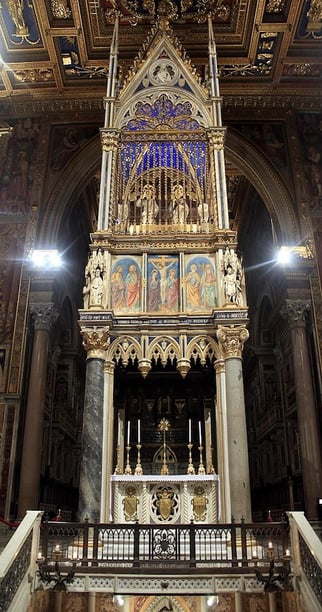 Wiki ktulu / CC BY 3.0, via Wikimedia Commons
Wiki ktulu / CC BY 3.0, via Wikimedia Commons
Tombs
With their relics and their occasional foundation above burial spots, Rome’s churches participate in the “lavish tomb” instinct of earlier cultures. However, because of Christians’ belief in resurrection, Rome’s approach to tomb architecture has been somewhat distinctive. Some magnificent pre-Christian tombs remain in Rome, including the Pyramid of Cestius and the Mausoleum of Augustus (excavated in the 1930s by Mussolini). These serve as monuments to the past. However, the largest pre-Christian tomb in the city center, the Mausoleum of the Roman Emperor Hadrian, was repurposed as a palace in the Middle Ages and remains a palace museum today.
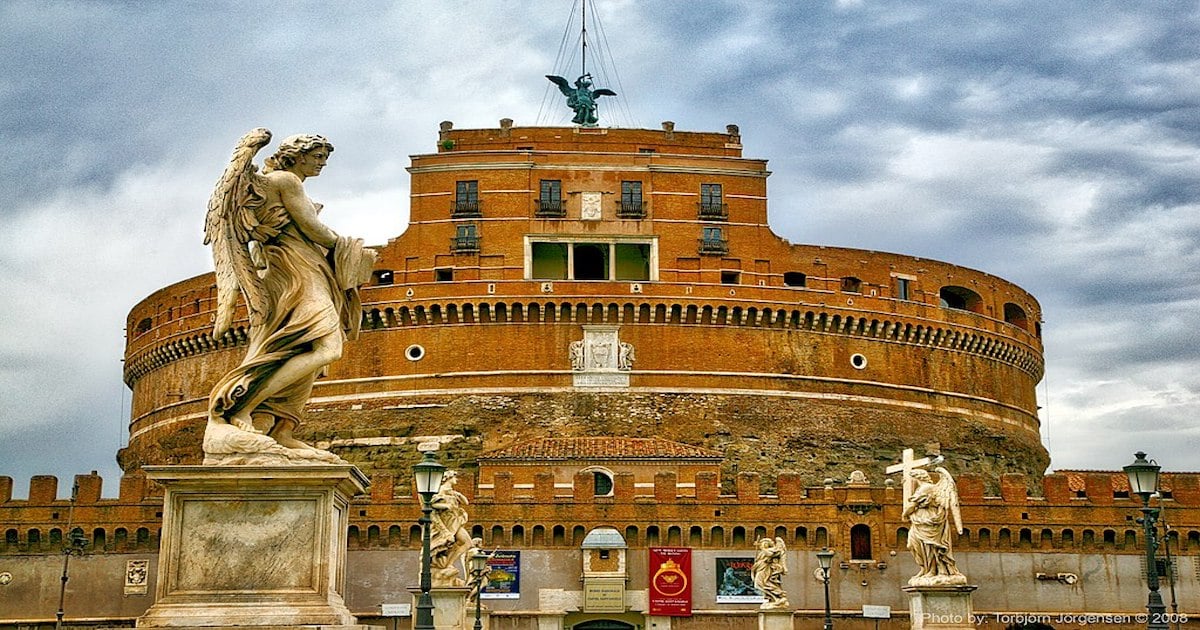 Torbjorn Toby Jorgensen / CC BY-SA 2.0, via Wikimedia Commons
Torbjorn Toby Jorgensen / CC BY-SA 2.0, via Wikimedia Commons
Rome’s Christian tombs, meanwhile, do not store up goods for the afterlife as the tombs of many pre-Christian cultures did. Rather, they often host worship and serve as gateways to transcendence. St. Peter’s itself is a tomb, of sorts (built over the place of Peter’s death and burial); however, it is a place of gathering, worship, and beauty first and foremost. The beloved church of San Lorenzo Fuori le Mura, still adjacent to Rome’s largest cemetery, was also built upon a tomb—the tomb of a bishop martyr who gave everything to the poor. Another important tomb-church is the lovely Basilica of St. Agnes in the north of Rome, built into the side of a catacomb next to Agnes’s burial spot. In these spaces, the remains of the deceased are not hidden away in darkness but are preserved and admired in beautiful reliquaries, in anticipation of the moment when body and soul will be rejoined.
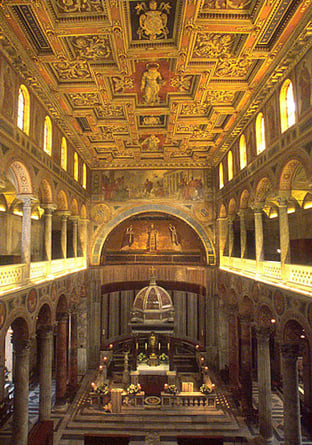 Parrocchia di Santa Agnese fuori le Mura / CC BY-SA 2.0, via Wikimedia Commons
Parrocchia di Santa Agnese fuori le Mura / CC BY-SA 2.0, via Wikimedia Commons
Statues
Human beings have venerated statues and idols since paleolithic times; early Christianity supplanted the idol (which seemed to contain the god it represented) with the picture or icon (which was frankly a copy or trace). However, once Christian culture had thoroughly permeated medieval Europe, the statue or idol form was resurrected again, to a different effect.
Now—imaginatively filtered through the icon-form that had taken precedence—statues of the holy could become three-dimensional icons. They did not pretend anymore to contain divine power; they just served as beautiful focuses and reminders. Accordingly, many of the earliest Christian statues were of relatively small scale and were often flat or open in the back. Later, the truly monumental sculpture was reclaimed again, but for its imaginative potential, not as a locus of power.
Examples of modest, early religious sculptures in Rome include the small bronze statue of St. Peter near the altar in St. Peter’s Basilica, dating from around 1300, and the Santo Bambino of Aracoeli, a small wooden statue of the child Jesus that probably originated in the fourteenth century (it has since been stolen and replaced by a replica). More monumental sculptures—to rival the idols of the ancient world—include Michelangelo’s famous Pieta near the entrance of St. Peter’s and the massive statues of the Apostles at St. John Lateran.
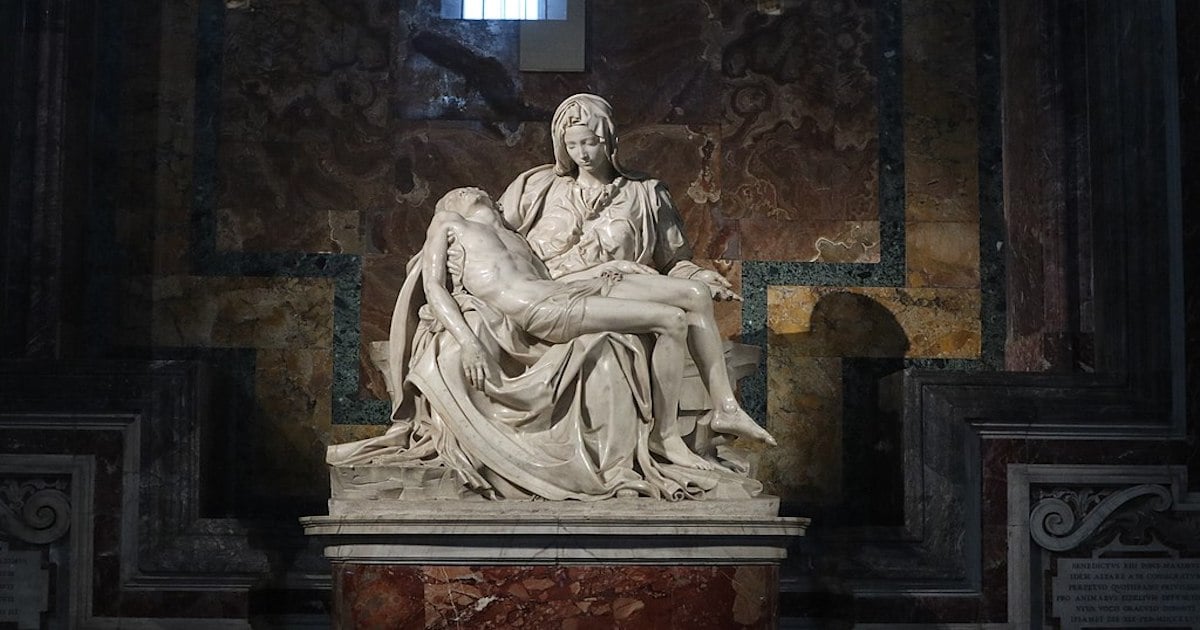 Michelangelo / CC BY-SA 4.0, via Wikimedia Commons
Michelangelo / CC BY-SA 4.0, via Wikimedia Commons
Icons
The icon form, meanwhile, can be found everywhere in Rome, along with a million variations. Indeed, during the Italian Renaissance, the simple icon gave rise to a rich tradition of visual storytelling (unfolding majestically, panel after panel) that still inspires artists today. In Santa Maria in Trastevere, a beautiful eighth-century icon of Mary and Jesus is complemented on the walls behind by a cycle of mosaics telling the story of Mary’s life. These mosaics, made during the Early Renaissance, harmonize with the ancient icon in style, and the mosaic figure of Mary has an iconic majesty throughout. However, the simple forms, the stillness, and the relative claustrophobia of the icon form have been expanded into a visual timeline replete with furniture, supporting characters, and shifting emotions. This transfiguration of the icon form would reach its peak in Raphael’s aptly-titled Transfiguration in the Vatican Pinacoteca, and in the unfolding drama of Michelangelo’s Sistine Chapel ceiling.
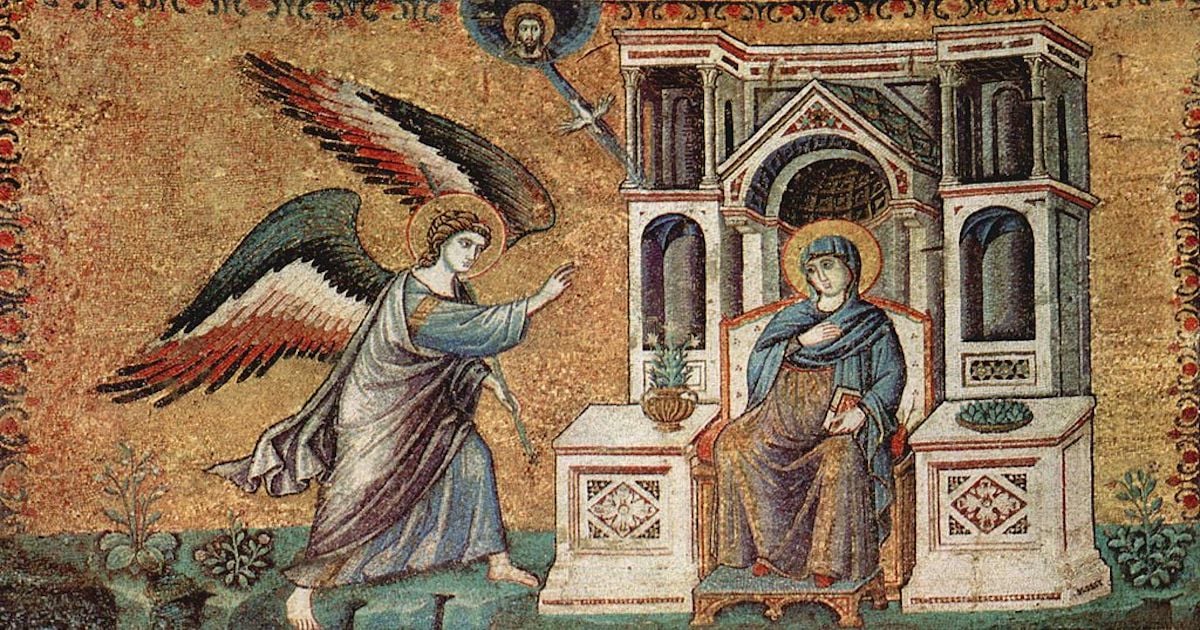 Pietro Cavallini / Public domain, via Wikimedia Commons
Pietro Cavallini / Public domain, via Wikimedia Commons
Costume
Finally, travelers in Rome today can still feel, deeply and wonderingly, the enduring and intentional process of transformation through dress. Visitors who participate in one of the many religious services available in Rome’s almost 1000 churches will see priests and their assistants dressed in often opulent garments that echo the theme of the liturgical season. Visitors to the Vatican may see high officials, and certainly, Swiss Guards, dressed in costumes jarring to modern eyes but soberly redolent of their wearers’ important roles.
Even visitors who stroll on Rome’s many streets will see consecrated individuals from all over the world (priests, nuns, monks) wearing the uniform specific to their fellowship. Many of these were designed in ancient times and bear little resemblance to what moderns wear. But whether simple or lavish, they mark their wearers as participants in something larger than themselves.
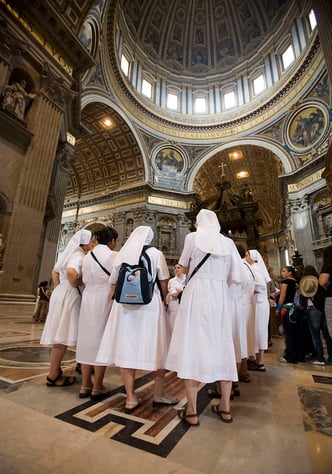 © Jorge Royan / http://www.royan.com.ar
© Jorge Royan / http://www.royan.com.ar
City of Layers
Many scholars call Rome a “palimpsest city”—perhaps the foremost of this kind in the world. The word “palimpsest” is a mouthful, but it refers to a writing surface that is erased and reused and erased again. Over the course of its use, traces of its earlier communications remain, with an end result that is muddy, complex, agglomerated, and layered.
Founded almost three thousand years ago, Rome has been built of layers that enrich and expand upon their ground. Ancient tomb treasure-chambers have become airy ecclesiastical palaces. Underground cemeteries have become glittering portals to heaven. Enormous statues have become humble, yet dramatic, gestures toward the transcendent. Far from being completely erased, the past has been taken up and augmented—given new meaning and adorned with new, unexpected beauties.
As I’ve hinted in earlier blog posts, so many of these forms have been ripped from their roots and adapted to modern beliefs and priorities. As in the case of Washington D.C., for example, “high points,” often complemented by huge cult statues, are approached by grand roads that open a vista onto their destination—all in the service of politics and government. In D.C.’s National History Museum, “relics” (such as, famously, Judy Garland’s ruby slippers and Archie Bunker’s chair) are “venerated” by tourists who approach their gleaming glass cases with awe. Resorts and amusement parks also use the grandeur and rhythm of past sacred architecture and urban planning to create a fleeting, anchorless exhilaration for their visitors. Halloween partiers, cosplayers, and wealthy socialites experiment endlessly and frivolously with transformation through dress.
 RadioFan at English Wikipedia, CC BY-SA 3.0, via Wikimedia Commons
RadioFan at English Wikipedia, CC BY-SA 3.0, via Wikimedia Commons
But if the genius of modernity was to dissect, disperse, and replicate—from assembly lines, to strip mining, to the transatlantic slave trade—postmodernity is rediscovering the importance of connection. Forms cannot, ultimately, satisfy when disconnected from their roots. In our ongoing quest for transcendence—through modern high places, pilgrimages, and “idols” of all different kinds—we are gradually rediscovering the genius of our ancestors. We are gradually learning that human spirituality is not properly the individual pursuit of bliss, but a grassroots unfurling of deep and unifying life. In their earnest harmonies, these unfurlings recall the philosopher Teilhard de Chardin’s sublime words: “Everything that rises must converge.”


